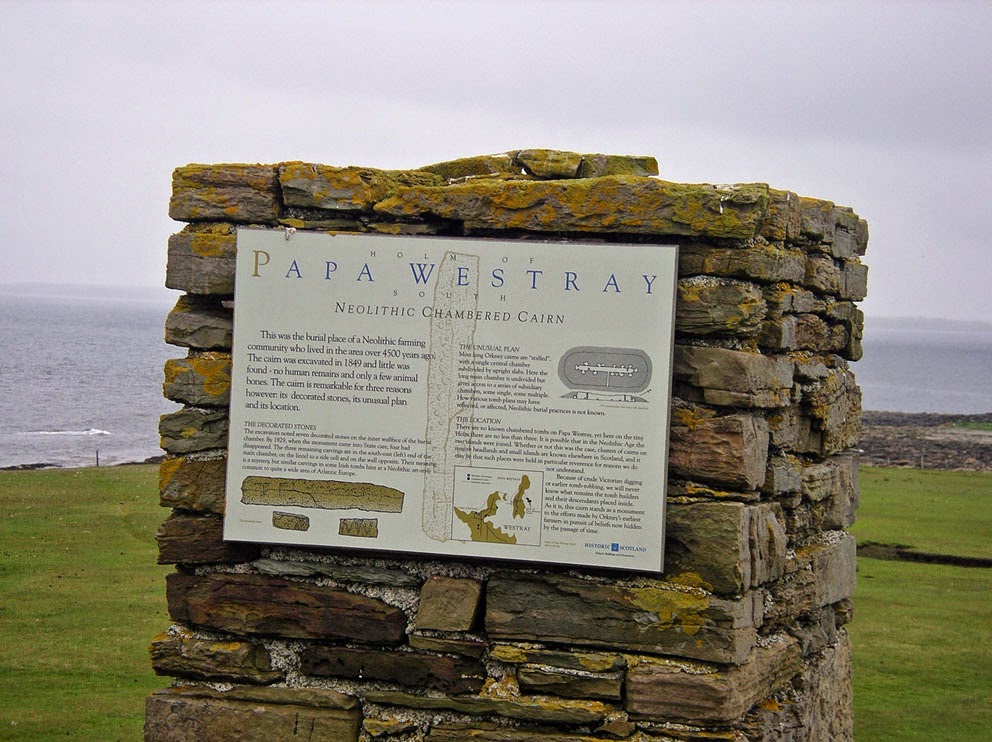Can you remember the exact date you first wanted to visit a specific island? I do, for it was on December 30, 1990, that I read something that made me want to visit Westray of the Orkney Islands. On that date my wife and I were in Vancouver BC visiting its many bookshops, as they always have a better selection of old Scottish books than the stores in Seattle. One of the books we bought that day was T. Ratcliffe Barnett's The Road to Rannoch and the Summer Isles (1924); which I devoured as soon as we returned to the hotel.
The tales in this wonderful book inspired several walks I would eventually make in the Hebrides. But one of the chapters stood out above the rest, as it described an airy walk to a hidden cave in Orkney. The chapter was called The Bad Step: A Jacobite Hidie Hole in the Orkneys. It described how William Balfour of Trenabie (in the northeast corner of Westray), supported the Jacobites in the '45. And as Barnett says in his book, after the loss in the '45 "Balfour and his friends '...were compelled to skulk in caves and dens of the earth'. Some of these hideouts became known as 'Gentlemen's Caves', and the most remote, and hard to reach of these was below the cliffs of Noup Head, where Balfour and 11 companions spent an entire winter.
In his book, Barnett describes searching in vain for the route down the 200-foot-high cliffs to the cave. And then how he found a local man that guided him there along a series of ledges. The route involved crossing the 'Bad Step', where you have to cross a gap in a ledge, where a misstep meant plunging 80-feet to the sea.
After reading this story (24 years ago) I decided I wanted to go there someday. And so when I found myself on Westray two weeks ago I decided to look for the cave. From Pierowall I hiked the four miles to Noup Head Lighthouse. It was a sunny, hot day, and the views from the lighthouse were stunning.
 |
| Noup Head Lighthouse |
From the lighthouse I followed the cliff-tops to the south. It was a wonderful walk, the cliffs covered with nesting seabirds, including hundreds of gannets.
I had the grid coordinates for the cave (HY 398 486), and after walking for a mile I reached the spot. But, as had happened to Barnett, I could not find a route to the cave. You definitely need a local to show you the way. I was disappointed, but I also realized, while looking down the shear cliff, that I would probably not have the nerve to follow the route even if I'd found it. When I first read about the airy walk to the cave I was in my 30s, and would have had no such second thoughts. But now, nearly 25 years older, I was much more cautious. I decided that standing on the cliff above the cave would have to suffice, and I would not seek a local to show me the way. The decision was made easier by the fact that in the coming days I would be sailing by here, and so I would be able to get a close look at the cave from the sea.
Two days later the ship Zuza left Westray and sailed around Noup Head. We were on our way south to Hoy, and after rounding the head we slowed down to admire the cliffs and search for the cave. The cave was easily spotted, its large entrance a few feet above the sea. You can see it to the left of centre in the next photo, and to the right you can see the sloping ledges that give access. I am not sure where the notorious 'Bad Step' is, but it looked as if there might be more than one. It is amazing to think of those 12 men spending a winter there with no fire, as the smoke would have given them away. It was also amazing to finally see this historic spot that I'd read about so long ago, on a dark winter's day, in a hotel room 4000 miles away.
 |
| The Gentlemen's Cave |














































